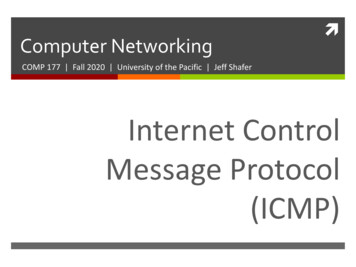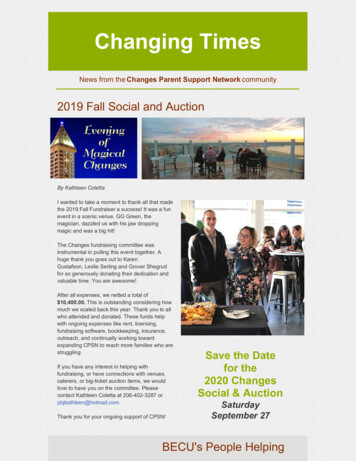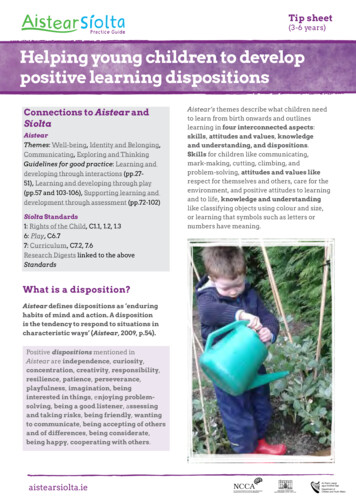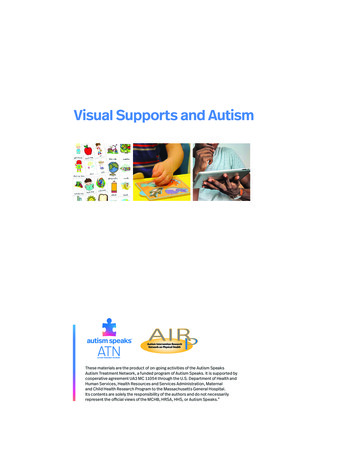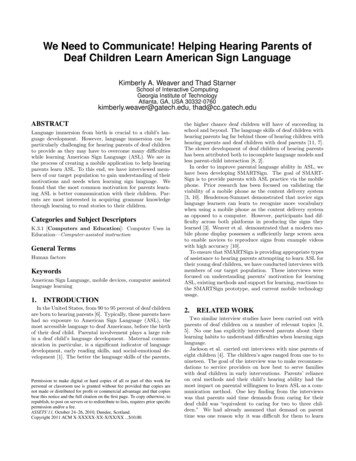
Transcription
We Need to Communicate! Helping Hearing Parents ofDeaf Children Learn American Sign LanguageKimberly A. Weaver and Thad StarnerSchool of Interactive ComputingGeorgia Institute of TechnologyAtlanta, GA, USA 30332-0760kimberly.weaver@gatech.edu, thad@cc.gatech.eduABSTRACTLanguage immersion from birth is crucial to a child’s language development. However, language immersion can beparticularly challenging for hearing parents of deaf childrento provide as they may have to overcome many difficultieswhile learning American Sign Language (ASL). We are inthe process of creating a mobile application to help hearingparents learn ASL. To this end, we have interviewed members of our target population to gain understanding of theirmotivations and needs when learning sign language. Wefound that the most common motivation for parents learning ASL is better communication with their children. Parents are most interested in acquiring grammar knowledgethrough learning to read stories to their children.Categories and Subject DescriptorsK.3.1 [Computers and Education]: Computer Uses inEducation—Computer-assisted instructionGeneral TermsHuman factorsKeywordsAmerican Sign Language, mobile devices, computer assistedlanguage learningthe higher chance deaf children will have of succeeding inschool and beyond. The language skills of deaf children withhearing parents lag far behind those of hearing children withhearing parents and deaf children with deaf parents [11, 7].The slower development of deaf children of hearing parentshas been attributed both to incomplete language models andless parent-child interaction [8, 2].In order to improve parental language ability in ASL, wehave been developing SMARTSign. The goal of SMARTSign is to provide parents with ASL practice via the mobilephone. Prior research has been focused on validating theviability of a mobile phone as the content delivery system[3, 10]. Henderson-Summet demonstrated that novice signlanguage learners can learn to recognize more vocabularywhen using a mobile phone as the content delivery systemas opposed to a computer. However, participants had difficulty across both platforms in producing the signs theylearned [3]. Weaver et al. demonstrated that a modern mobile phone display possesses a sufficiently large screen areato enable novices to reproduce signs from example videoswith high accuracy [10].To ensure that SMARTSign is providing appropriate typesof assistance to hearing parents attempting to learn ASL fortheir young deaf children, we have conducted interviews withmembers of our target population. These interviews werefocused on understanding parents’ motivation for learningASL, existing methods and support for learning, reactions tothe SMARTSign prototype, and current mobile technologyusage.1. INTRODUCTIONIn the United States, from 90 to 95 percent of deaf childrenare born to hearing parents [6]. Typically, these parents havehad no exposure to American Sign Language (ASL), themost accessible language to deaf Americans, before the birthof their deaf child. Parental involvement plays a large rolein a deaf child’s language development. Maternal communication in particular, is a significant indicator of languagedevelopment, early reading skills, and social-emotional development [1]. The better the language skills of the parents,Permission to make digital or hard copies of all or part of this work forpersonal or classroom use is granted without fee provided that copies arenot made or distributed for profit or commercial advantage and that copiesbear this notice and the full citation on the first page. To copy otherwise, torepublish, to post on servers or to redistribute to lists, requires prior specificpermission and/or a fee.ASSETS’11, October 24–26, 2010, Dundee, Scotland.Copyright 2011 ACM X-XXXXX-XX-X/XX/XX . 10.00.2.RELATED WORKTwo similar interview studies have been carried out withparents of deaf children on a number of relevant topics [4,5]. No one has explicitly interviewed parents about theirlearning habits to understand difficulties when learning signlanguage.Jackson et al. carried out interviews with nine parents ofeight children [4]. The children’s ages ranged from one to tonineteen. The goal of the interview was to make recommendations to service providers on how best to serve familieswith deaf children in early interventions. Parents’ relianceon oral methods and their child’s hearing ability had themost impact on parental willingness to learn ASL as a communication method. One key finding from the interviewswas that parents said time demands from caring for theirdeaf child was “equivalent to caring for two to three children.” We had already assumed that demand on parenttime was one reason why it was difficult for them to learn
ASL. Managing the doctor and therapist meetings for theirdeaf child can also put a significant limit on parental freetime.Meadow-Orlans et al.’s data comes from a mixed methods approach including surveys, individual interviews andfocus group interviews [5]. The purpose of their study wasto gain basic understanding of the experiences of parents ofyoung deaf children. They focused on reactions to identification, communication method decisions and reactions tocare providers. Parents sometimes had no choice over whatcommunication methods they used. Instead they were limited by the opportunities available to them based on theirplace of residence. Two reasons for parents deciding to signincluded giving their children any chance they could to communicate and leaving as much choice in the hands of theirchildren when they were older. Mothers rated their skillsin sign language better than the fathers 95 percent of thetime. An interesting area for investigation could be exploring the opportunities for supporting fathers’ learning ASLusing SMARTSign.Vaccari and Marshark wrote a summary paper on the impact of parental communication ability on a deaf child’sdevelopment [9]. They found that the deaf children whoare most competent in social and linguistic development arethose whose parents engaged them actively in linguistic interaction from a young age. Linguistic interaction is difficultfor hearing parents with deaf children who have so little formal sign training that they cannot use it for daily needs,feel uncomfortable signing, and only sign when directly addressing their child. The goal of my interview study is todetermine how to address these three problems.3. METHODThe study took the form of a semi-structured interviewwith hearing parents of deaf children. The interview topicsfollowed four categories: family, ASL learning, prototype reactions, and phone ownership. The goal of the family topicwas to understand basic background information about theparents and their deaf children to determine the level ofsupport parent and child had for learning ASL. Conversation about ASL learning was directed towards uncoveringcurrent difficulties parents experience while learning ASL inorder to determine if SMARTSign can be designed to alleviate those difficulties. Parents were shown the prototypeSMARTSign system to gauge reactions and determine utility and desirabilty of the existing functions. Because theultimate goal of this research project is to deploy a workingsystem longterm to parents, the phone ownership topic wasimportant for understanding what devices were favored byparents and availability of data plans.3.1 Parental RecruitmentParents were recruited through a number of methods. Emails were sent both to the SKI-HI (Sensory [Kids] Impaired Home Intervention) coordinator at Georgia PINES,the state-wide early intervention program for Georgia andto the social worker at the Atlanta Area School for the Deaf.Parents were also recruited from the 10th Annual EarlyHearing Detection and Intervention Conference (EHDI 2011)in Atlanta, Georgia. EHDI is a national conference withtracks for both practitioners and parents. Only one parentwas already acquainted with the SMARTSign project beforeparticipating in the interview. She is a regular user of anearly web-based iteration.3.2Participant DemographicsEleven parents were recruited for the interview study, ninemothers and two fathers, representing ten different families.One of the participants is currently a single parent and oneof the other participants was a single parent when her childwas born but is now married. The other eight families represented two-parent households. Due to recruitment at anational conference, participants represented eight differentstates from three geographic regions of the United States,the Southeast, Northeast, and Midwest. A summary of theparticipant demographics is shown in Table 1.The parents interviewed had between one and seven children (µ 2.5, σ 1.84). All of the participants were theparents of at least one deaf or hard of hearing child. Onemother had two children who were hard of hearing. Threeof the parents only had one child.The ten families included eleven deaf or hard of hearingchildren. Their ages varied between 10 months and 16 years(µ 5.26 years, σ 4.04 years). The age of their child’shearing loss identification also varied between birth and 3years (µ 11.18 months, σ 12.65 months). Four of thechildren were identified at birth. Many of the parents reported that their children had initially failed their neonatalhearing tests, but passed on follow up tests which lead todelayed diagnosis. Despite the late identification of deafness for some of the children, only one child’s deafness wasnot congenital or acquired shortly after birth. This childbecame deaf after suffering from meningitis at 13 months.Three of the eleven children had other serious medical conditions. This ratio is consistent with the findings of MeadowOrlans et al. [5]. The two deaf siblings have cystic leukoencephalopathy which is a progressive degeneration of the brain’swhite matter. Another child is autistic. One child is adopted,and the birth mother abused drugs: high levels of bilirubin(extreme jaundice) caused the deafness which was not diagnosed until the child was 3 years old.All of the children possessed some form of sensory device:hearing aid or cochlear implant. Five of the children had atleast one ear with a cochlear implant although two parentsreported that their children did not like to wear their implants. Five of the children wore hearing aids. One of thechildren wore a cochlear implant and a hearing aid.4.MOTIVATION FOR LEARNING ASLDiscussions with educators and social workers early inthe SMARTSign development process indicated that parents had no interest in learning ASL. In our interviews,we learned parents had a number of reasons for decidingto learn ASL. The primary reason was communication withtheir child which is consistent with previous parent interviewstudies. Some parents also expressed an interest in providing their children with a bilingual education and access tothe deaf community. Parents also related some negativesthat made their decision more difficult.4.1CommunicationEight of the ten families said that a desire for communication with their child was a reason for their decision tolearn ASL. One mother said that when her parent mentorcame to her home and told her all of the potential options
er67mothermother8910motherfathermotherfather&Table 1: Summary of participating family demographicsRegionChildrenChildIdentified Sensory DeviceMedical Issues(Hearing:Deaf)AgeSoutheast (0:1)8 yrs2 yrscochlear implantNortheast (2:1)3.5 yrs 3 moshearing aidSoutheast (1:1)16 yrs13 moscochlear implant meningitis(does not use)Southeast (2:2)3.5 yrs 18 mos & hearing aidscystic leukoen& 2 yrs birthcephalopathyNortheast (6:1)6 yrs2 yrscochlear implant(does not like)Northeast (1:1)4 yrsbirthcochlear implantSoutheast (1:1)5 yrsbirthcochlear implant autistic& hearing aidMidwest(0:1)10 mos 5 moshearing aidMidwest(1:1)5 yrsbirthhearing aidSoutheast (0:1)4 yrs3 yrscochlear implant maternal drugusage, adoptedher decision was based on how her son could learn languagethe fastest. Other parents felt like they had no choice. Forothers it was less of a conscious decision and more the onlyoption they had. Communication was not happening by anyother method, and they “had to do something.”One mother realized that she had to work harder to learnafter an experience at an amusement park. Her son wasfour and playing in the pool so was not wearing his cochlearimplant. The lifeguard was whistling at him to tell himnot to climb over the edge. Without his implant, the soncouldn’t hear the whistle. The mother had no idea how toattract her son’s attention and she felt embarrassed whenall the other families turned to stare at her. When she triedto take her son away, he could not understand her.The Baby Sign movement is having a positive effect onparents’ willingness to learn sign language. Two mothersstated that they had already planned on using sign language with their child before identification as deaf. Onemother had already used Baby Sign successfully with hertwo older children. She said it didn’t feel as “scary” as shefeels it might be for others because of her prior exposure.Another mother said that she had always wanted to teachher children sign language and her husband pointed thatdesire out when they learned their child was deaf. Her reaction was to say “that’s not the point.” Familiarity is noteverything, there is a difference between learning a handfulof vocabulary as a temporary measure while a child is youngby choice and learning a new language as a primary meansof communication.Some parents treat sign language as a temporary measure until their child gets implanted, their hearing aids allowthem to learn language, or their hearing gets better. In somecases a transition to oral communication might be possible.One mother related how as her son masters a spoken word,he will drop the use of the relevant sign. This viewpointcan also backfire. One mother said they had started learning ASL and then they stopped when he was implanted. Atage three, their son had behavioral problems due to lack ofcommunication. They then decided to start signing againand have been doing so for 13 years.In two other cases, this lack of communication becameso apparent that their child became very frustrated. OneLearningDuration6 yrs2.5 yrs13 yrs1.5 yrs4 yrs3 yrs5 yrs4 yrs3 mos2 yrsfamily said that they and their son were frustrated becausethey didn’t know what he wanted, and they didn’t know howto respond to him. Another mother said that knowing singlewords wasn’t enough to ease the communication barrier.If parents wait too long to learn ASL, then they find theyhave to play catch up with their child’s language abilities.One mother reported experiencing this situation. The childbecame the language model for the parent. This situationbecomes frustrating not just for the child but for the parentas well.4.2Linguistic and Cultural BenefitsParents also made the decision to learn ASL for morethan just communication. Three parents expressed interestin ASL as a way to provide their children with a bilingualeducation. One mother said “we always considered it an option because if nothing else, we figured he’d be bilingual.”This sentiment is evidence that old ideas of learning onelanguage impairing the ability to learn a second languageare becoming less prevalent. Bilingualism is now thought ofas an advantage rather than a disadvantage. Another parent said a bilingual education would help her child “learnas much as possible.” One father took his son to Gallaudet(the university for the Deaf) in Washington DC shortly after his child was identified. Despite pressure from those inhis community who wanted him to focus on one communication method, either oral or signing, the father said thatthey wanted to “empower him [their son] with choices.” Thefather said that their son would then have the opportunityto choose his desired communication method later.Two families mentioned the role of the Deaf Communityin their decision process. One parent said that he wantedto learn ASL because it was the language of choice for theDeaf Community. Another parent said the experiences of aDeaf friend who learned sign first and then started learningoral convinced them to learn sign language. In the firstexample the father is learning ASL to help his child gainaccess to the Deaf Community. In the second example, theDeaf adult served as proof that sign language did not hurta child’s chances to eventually learn to speak.ASL has one other benefit for parents as expressed by oneof the fathers. In this father’s state, the dominant language
promoted by early education providers is Signed Exact English (SEE). SEE is another visual language but is basedon English grammar. SEE goes farther than just sign language in English word order and also includes signs for wordendings such as “-ed” and “-ing.” The father said that SEEwas unnatural, too difficult to learn, and his son had givenup using it. The feeling of dislike for SEE’s difficulty andappreciation for ASL was shared by another mother.Two of the parents made a point to emphasize how theirchildren were normal, though deaf. These parents focusednot just on communication with their child but inclusion infamily life. One mother, after listening to stories by a deafindividuals who spent childhoods sitting at the dinner table not being engaged by their family and not knowing thenames of their aunts and uncles, resolved that her child’sexperience would not be the same. Another father went tovisit Gallaudet to make sure he explored all of the opportunities his son could have and to ensure that all possibleavenues were open for his child to choose. Both of theseparents are working to make sure to find ways to make theirchildren’s childhood “the best possible experience” as onemother expressed.4.3 DisincentivesThere are a number of disincentives which make the decision to learn ASL difficult. One mother related her annoyance of going out and having people stare at them. Kidswould come up to her and ask what was wrong with herson. Using a visual language automatically singles you outas being different which can be uncomfortable for parents.Lack of prior experience with deafness can make it difficultto embrace a new language and culture for their child. Onlyone parent had prior experience with Deaf individuals beforetheir own child’s identification. One mother was a specialeducation teacher even before her child was identified. Shesaid that all she was taught about deafness in school was“deaf is bad.”ASL is not an easy language to learn. Even parents whohave been learning ASL for many years are hesitant to saythey know or use ASL. A mother claimed that the sign theyused in the house was more of a pidgin of ASL. One mother,who works in her son’s school, says that she is uncomfortablewhen she is asked to read “aloud” at school because she isconstantly worrying about whether she is signing correctly.She also said that when she first started signing she wasafraid to sign in the grocery store for fear that people mightsee her doing it wrong. One father stopped signing becausehis child said his signing was bad and was embarrassing.Now the father doesn’t have the confidence to use ASL withhis Deaf friends.Treating sign language as if it is a temporary languagebefore oral English is acquired can be another disincentiveto learning ASL fully. As technology for hearing aids andcochlear implants advances there are some who are able togain enough ability to interact in society without the needfor sign language. Religion can also play a role in the beliefthat ASL knowledge is only a temporary necessity. None ofthe parents expressed this belief personally but one fatherrelated an experience he had with his father. The grandfather quoted how Jesus healed the deaf, the blind, and themute implying that faith could heal his grandson as well.The father’s reply was “My son is not broken. He is whole.He just happens to be whole and not hearing.” This attitudeTable 2: Summary of Learning ToolsLearning ToolPositive Neutral NegativeEarly Interven- 411tion ServicesDVDs422Websites261Classes313Mobile Phone020Books124Total689727is more likely to help his child develop the skills necessaryto succeed in a hearing society.Another barrier to learning sign language is lack of opportunities to practice. Two mothers talked about this. Onemother has experienced frustration because her son is autistic. She feels that the response from her son is not enough.Later on she did state that he does surprise her sometimeswhen he uses a sign that she was unaware he knew. Themother whose child is still an infant talks about how difficult it is when she cannot use her sign language every day.Her child does not yet have the capacity to learn more complex language, so she has to work and focus on learning soshe is ready to teach when her child is ready.5.LEARNING TOOLSParticipants were asked about the tools they used to learnand practice their sign language skills. While most parentsagreed that classes were the most beneficial, they reportedusing a wide range of tools including books, DVDs, andwebsites. Some parents even talked about tools they usedwhile they were mobile. Many states provide services forparents where an educator will come into the home to helpparents and family members. Table 2 shows a summaryof participant use of and reaction to a number of differenttools for learning ASL. We will start by investigating characteristics of the tools which had the most positive reactions(Early Intervention Services) and the most negative reactions (books).5.1InterventionsEarly Intervention Services received the most positive comments of any of the other learning tools. Of the ten families,six had access to early intervention services. These servicesare typically provided for the family while the child is between the ages of zero and three and can provide many different forms of assistance. One parent was matched with adeaf mentor. The mentor played a significant role in helpingthe mother with her confidence in learning sign language andwith helping her feel comfortable interacting with the Deafcommunity. Other home providers help parents by teachingthem ASL in their homes. One home provider taught theextended family as well as the parents in their home oncea week. Home providers can also help parents learn eventspecific vocabulary. One mother whose home provider visitstwice a month talked about looking ahead at the calendarand asking her to help with vocabulary related to visitingthe dentist office so that her son would not be nervous. Another service can be helping parents keep pace with vocabulary related to the topics their child is learning in school.A third way home providers can assist parents is by helping them with the transition to communicating in a more
visual language. One parent talked about how his earlychildhood educator did a good job of teaching about communication and turn-taking to help them understand howto convey the significance of the signs to their child. Interventions are largely positive experiences for parents becausethey are largely customized to the family, providing relevantand timely information.Not all reactions to the home providers were positive. Oneparent commented about the wide range of potential personalities and styles. She commented that one home providerwill argue with parents about the proper way to performsigns. Given that parents are already experiencing low confidence with their sign language skills, this confrontationalstyle could discourage them further. Parents may also feeloverwhelmed by the amount of information provided by theirhome providers at once. Despite these problems, the parentadmitted that she knew the home providers meant well andthat it was better than not having any support like thosewho lived in more rural regions of her state. The disadvantage of Early Intervention Services then lies in the variabilityof the home providers.5.2 BooksParents reacted to books the most negatively. Seven ofthe ten families reported using books to help them learnsign language. Of those seven families, four of the parentswere not happy with the books they had. Parents foundthem difficult to understand. Because motion plays a largerole in the meaning of a sign, it can be difficult to conveya complete sign through static images. One mother said itwas difficult to look at a single picture with lots of arrowspointing in “seemingly random” directions and figuring outwhat to do. One father said that he does not know the signfor FOREVER because of the two dimensional representation. He knows how the sign ends but cannot figure out howto start the sign.Parents reported owning big ASL dictionaries, pocket dictionaries for quick reference while mobile, text books, andother reference books. All of these books are focused on vocabulary acquisition. One parent who reported not owningany books lamented the lack of real books in ASL to enableher to tell stories to her child.5.3 DVDsDVDs, while still focusing primarily on vocabulary, dohave an advantage over books in their ability to present signsin a more understandable format. DVDs were employedby eight of the ten families. The Signing Time series wasthe most popular with five of the families reporting its use.Signing Time is targeted at helping children learn signs, butmany of the parents felt they learned a lot from them as well.One mother said that the fact that the videos had sound withthem helped because she could put the DVD on and thenwhen the DVD said a word she was interested in learningshe could pay attention. With DVDs without an auditorycomponent it was easy to start playing one and then getdistracted and realize an hour later they were supposed tobe learning. Parents liked DVDs because they were able tosee the whole sign and how it was performed, unlike withthe books.Parents sometimes became frustrated with the DVDs because they were mostly focused on vocabulary. The songsprovided a little bit of flow, but for the most part the signswere not being presented together to create full phrases. Oneparent said there was too much extra in the DVDs and theyjust wished they could get to the vocabulary. Another disadvantage with the DVDs is that there was no assistance ifyou had difficulty learning a sign. You just had to watchthe section of the DVD over and over again until you understood. DVDs are meant to be played and watched for aduration, they are not as useful for quick referencing.One parent reported having an ASL story DVD and saidhe could follow the signs generally word for word, but whenthe video showed a classifier it would make him confused.Classifiers are signs that represent a general category of objects. Classifiers in ASL are similar to pronouns in Englishin that what they are referring to depends on their context of use. They can be used to represent an object, howit moves, or how it relates to other objects. This ambiguity is understandable for parents who have had a largelyvocabulary-based ASL education.5.4WebsitesWebsites are becoming more popular with parents. Onlyone family reported not using websites to help them learnsign language. Most families use dedicated sites for ASLsuch as ASL Pro, lifeprint.com or SigningOnline. All of thewebsites provide a dictionary. Some are not browsable without acquiring a login which may cost money. Lifeprint.comprovides different workbooks and practice tools. SigningOnline provides access to course material for a fee. Twofamilies reported using generic search strategies for findingsign videos online. One family uses YouTube. Another family searches for signs using Yahoo! and the search terms“sign language for” to find vocabulary. The problem withthe Yahoo! strategy is that sometimes she gets videos thatare not what she is looking for. It can be a very slow processto weed out the inappropriate videos.The advantages and disadvantages of the websites are similar to those of the DVDs. Parents like seeing the videosof the actual signs instead of the illustrations they find inbooks. But they also feel like they want to see more thanjust vocabulary. Support for more connected speech is limited. Websites have one advantage over DVDs in that theycan immediately find the sign they are looking for. Someparents felt that it was difficult to spend a lot of time online.5.5ClassesClasses received the most divided responses of all of thetools discussed. Seven of the families have attended formalclasses at some point in their attempts to learn ASL. Classesare typically offered through three different sources: highereducation institutions, schools for the deaf, and churches.Two families attended classes at higher education institutions. One mother took ASL 1 at the University of Georgiawhile she was a student. Unfortunately ASL was not considered a language by the university so it did not fulfill her language requirement. Another family took ASL 1 at the localcommunity college. This mother talked about the expense oftaking the class when they were not interested in the coursecredit. Three families attended classes at their local schoolfor the deaf. Reactions to these classes were largely positive. Parents talked about the fun games they played, thecamaraderie they gained from learning with other parentsin similar situations. One mother said she took ASL 1 and
2 multiple times each because every time she experiencedlearning from different deaf adults. One family attendedclasses at their church. They felt that there was too muchinformation at once. They were more interested in learningthe basics.Another mother who did not specify the location of herclasses said that she registered for ASL classes twice butdropped them. She felt that the class took too much time.The teacher spent most of the time talking and the motherfelt that she just was not learning enough to justify theamount of time spent. Over all it
American Sign Language, mobile devices, computer assisted language learning 1. INTRODUCTION In the United States, from 90 to 95 percent of deaf children are born to hearing parents [6]. Typically, these parents have had no exposure to American Sign Language (ASL), the most accessible language
